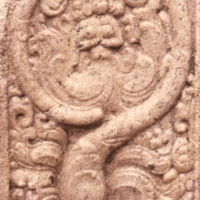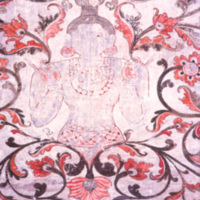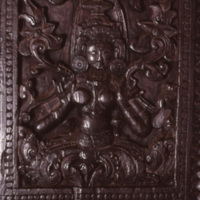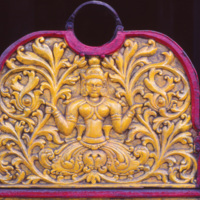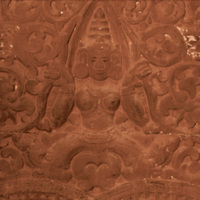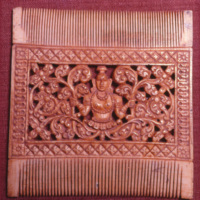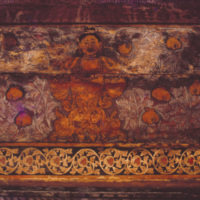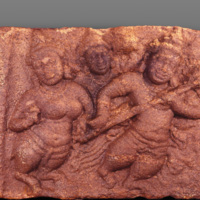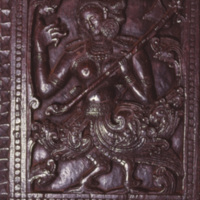Main Menu
AORC Libraries
Browse Items in Composite figures which are part female (11 total)
Composite figures which are part female
Description: Composite figures which are part female: Frequently met with in Sri Lankan sculpture and painting are figures which are only part female. The most popular among them are Narilata and Kinnari forms. They are female above and waist dowards the narilata are shown with foliage design and the Kinnaris take the form of birds.
Contributor: Co-Author: Seneviratna, Harsha
Collection: Women in Sri Lankan Sculpture and Painting
Composite figures (part female) - Narilata
Description: Among the auspicious symbols associated with the Kalpavruksa or tree of life on a stone pillar at the Atadage in Polonnaruva is this Narilata, with hands joined together in worship. These carved pillars have been attributed to the late Anuradhapura period (9th-10th century A.D.)
Contributor: Co-Author: Seneviratna, Harsha
Collection: Women in Sri Lankan Sculpture and Painting
Composite figures (part female) - Narilata
Description: This example of a Narilata motif belongs to the 14th century A.D. It is one of two such motifs painted on the overhead arch at the centre of the main shrine of the Lankatilaka temple near Gampola, Sri Lanka.
Contributor: Co-Author: Seneviratna, Harsha
Collection: Women in Sri Lankan Sculpture and Painting
Composite figures (part female) - Narilata
Description: Expressed in the medium of wood is this 17th century A.D. wood carving of a Narilata which occurs as a decorative panel on a pillar at the Ambakke devale, Sri Lanka.
Contributor: Co-Author: Seneviratna, Harsha
Collection: Women in Sri Lankan Sculpture and Painting
Composite figures (part female) - Narilata
Description: Painted at the two ends of a palanquin or ‘dolava’ used in the annual procession at the Gadaladeniya Vihare in the Kandy district, Sri Lanka, are narilata motifs. This representation is probably a work of the Kandyan period, although the temple itself dates to the 14th century A.D.
Contributor: Co-Author: Seneviratna, Harsha
Collection: Women in Sri Lankan Sculpture and Painting
Composite figures (part female) - Narilata
Description: This representation of the Narilata on the lintel of the wooden doorway of the Vakirigala temple in the Kegalle district, Sri Lanka, is extremely important for its symbolic meaning. Taking the place of the Laksmi motif, the Narilata seems to symbolize prosperity and good fortune. The carving seems to belong to the Kandyan period (1529-1815 A.D.).
Contributor: Co-Author: Seneviratna, Harsha
Collection: Women in Sri Lankan Sculpture and Painting
Composite figures (part female) - Narilata
Description: This comb with a carving of a Narilata is one of a large selection of ivory combs of the Kandyan period exhibited at the Colombo National museum.
Contributor: Co-Author: Seneviratna, Harsha
Collection: Women in Sri Lankan Sculpture and Painting
Composite figures (part female) - Narilata
Description: An elaborate narilata motif which consists of the central female forms and a host of other female heads within the creeper design is seen painted on the wooden ceiling of the ground floor of the Temple of the Tooth in Kandy, Sri Lanka. It is a rare form of the narilata motif and serves a decorative purpose.
Contributor: Co-Author: Seneviratna, Harsha
Collection: Women in Sri Lankan Sculpture and Painting
Mythical creatures (part female and part bird) - Kinnaris
Description: Exhibited at the Museum in the Isurumuniya temple premises is this group of Kinnaras among whom is a Kinnari (female Kinnara). Traditionally they are thought to be heavenly musicians. Here the male carries a musical instrument. The stone carving has been dated to about the 5th or 6th century A. D.
Contributor: Co-Author: Seneviratna, Harsha
Collection: Women in Sri Lankan Sculpture and Painting
Mythical creatures (part female and part bird) - Kinnaris
Description: This is a 17th century A.D. wood carving of a Kinnari (female Kinnara) holding a musical instrument at the Ambakke devalaya, Sri Lanka.
Contributor: Co-Author: Seneviratna, Harsha
Collection: Women in Sri Lankan Sculpture and Painting




